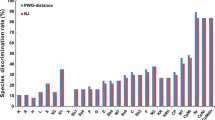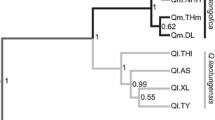Abstract
Primers previously developed to amplify specific non-coding regions of the mitochondrial genome in Angiosperms, and new primers for additional non-coding mtDNA regions, were tested for their ability to direct DNA amplification in 12 conifer taxa and to detect sequence-tagged-site (STS) polymorphisms within and among eight species in Picea. Out of 12 primer pairs, nine were successful at amplifying mtDNA in most of the taxa surveyed. In conifers, indels and substitutions were observed for several loci, allowing them to distinguish between families, genera and, in some cases, between species within genera. In Picea, interspecific polymorphism was detected for four loci, while intraspecific variation was observed for three of the mtDNA regions studied. One of these (SSU rRNA V1 region) exhibited indel polymorphisms, and the two others (nad1 intron b/c and nad5 intron1) revealed restriction differences after digestion with Sau3AI (PCR-RFLP). A fourth locus, the nad4L-orf25 intergenic region, showed a multibanding pattern for most of the spruce species, suggesting a possible gene duplication. Maternal inheritance, expected for mtDNA in conifers, was observed for all polymorphic markers except the intergenic region nad4L-orf25. Pooling of the variation observed with the remaining three markers resulted in two to six different mtDNA haplotypes within the different species of Picea. Evidence for intra-genomic recombination was observed in at least two taxa. Thus, these mitotypes are likely to be more informative than single-locus haplotypes. They should be particularly useful for the study of biogeography and the dynamics of hybrid zones.







Similar content being viewed by others
References
Altschul SF, Gish W, Miller W, Myers EW, Lipman DJ (1990) Basic local alignment search tool. J Mol Biol 215:403–410
Birky CW Jr (1995) Uniparental inheritance of mitochondrial and chloroplast genes: mechanisms and evolution. Proc Natl Acad Sci USA 92:331–338
Bonen L, Williams K, Bird S, Wood C (1994) The NADH dehydrogenase subunit 7 gene interrupted by four group II introns in the wheat mitochondrial genome. Mol Gen Genet 244:81–89
Campbell DR (1991) Comparing pollen dispersal and gene flow in a natural population. Evolution 455:1965–1968
Chandelier A, du Jardin P, Avril C, Pâques M (1999) Identification of mitochondrial plasmid-like DNAs in Picea abies (L.) Karst. Plant Cell Rep 18:841–847
Demesure B, Sodzi N, Petit RJ (1995) A set of universal primers for amplification of polymorphic non-coding regions of mitochondrial and chloroplast DNA in plants. Mol Ecol 4:129–131
DeVerno LL, Charest PJ, Bonen L (1993) Inheritance of mitochondrial DNA in the conifer Larix. Theor Appl Genet 86:383–388
Duff RJ, Nickrent DL (1999) Phylogenetic relationships of land plants using mitochondrial small-subunit rDNA sequences. Am J Bot 86:372–386
Dumolin-Lapègue S, Pemonge M-H, Petit RJ (1998) Association between chloroplast and mitochondrial lineages in oaks. Mol Biol Evol 15:1321–1331
Fauron CMR, Moore B, Casper M (1995) Maize as a model of higher plant mitochondrial genome plasticity. Plant Sci 112:11–32
Fournier D, Perry DJ, Beaulieu J, Bousquet J, Isabel N (2002) Optimizing expressed sequence tag polymorphisms by single strand conformation polymorphism in spruces. For Genet 9:11–17
Fowler DP (1987) The hybrid white × Sitka spruce: species crossability. Can J For Res 17:413–417
Gugerli F, Sperisen C, Büchler U, Brunner I, Brodbeck S, Palmer JD, Qiu Y-L (2001a) The evolutionary split of Pinaceae from other conifers: evidence from an intron loss and a multigene phylogeny. Mol Phylogenet Evol 21:167–175
Gugerli F, Sperisen C, Büchler U, Magni F, Geburek T, Jeandroz S, Senn J (2001b) Haplotype variation in a mitochondrial tandem repeat of Norway spruce (Picea abies) populations suggests a serious founder effect during postglacial re-colonization of the western Alps. Mol Ecol 10:1255–1263
Isoda K, Shiraishi S, Watanabe S, Kitamura K (2000) Molecular evidence of natural hybridization between Abies veitchii and A. homolepis (Pinaceae) revealed by chloroplast, mitochondrial and nuclear DNA markers. Mol Ecol 9:1965–1974
Kubo T, Yamamoto MP, Mikami T (2000) The nad4L-orf25 gene cluster is conserved and expressed in sugar beet mitochondria. Theor Appl Genet 100:214–220
Kumar R, Lelu M-A, Small I (1995) Purification on mitochondria and mitochondrial nucleic acids from embryogenic suspension cultures of a gymnosperm, Larix × leptoeuropaea. Plant Cell Rep 14:534–538
Laroche J, Bousquet J (1999) The evolution of angiosperm mitochondrial rps3 group II introns in perennial and annual taxa: substitutions, insertions-deletions and homology to nad5 intron 1. Mol Biol Evol 16:441–452
Laroche J, Li P, Maggia L, Bousquet J (1997) Molecular evolution of angiosperm mitochondrial introns and exons. Proc Natl Acad Sci USA 94:5722–5727
Latta RG, Mitton JB (2001) Historical separation and present gene flow through a zone of secondary contact in ponderosa pine. Evolution 53:769–776
Lonsdale DM, Brears T, Hodge TP, Melville SE, Rottmann WH (1988) The plant mitochondrial genome: homologous recombination as a mechanism for generating heterogeneity. Phil Trans R Soc Lond B 319:149–163
Lu M-Z, Szmidt AE, Wang XR (1998) RNA editing in gymnosperms and its impact on the evolution of the mitochondrial coxI gene. Plant Mol Biol 37:225–234
Lunt DH, Whipple LE, Hyman BC (1998) Mitochondrial DNA variable number of tandem repeats (VNTRs): utility and problems in molecular ecology. Mol Ecol 7:1441–1455
McCauley DE (1997) The relative contributions of seed and pollen movement to the local genetic structure of Silene alba. J Hered 88:257–263
Mitton JB, Andalora R (1981) Genetic and morphological relationships between blue spruce, Picea pungens, and Engelmann spruce, Picea engelmannii, in the Colorado Front Range. Can J Bot 59:2088–2094
Mitton JB, Kreiser BR, Latta RG (2000) Glacial refugia of limber pine (Pinus flexilis James) inferred from the population structure of mitochondrial DNA. Mol Ecol 9:91–97
Mohr S, Schulte-Kappert E, Odenbach W, Oettler G, Kück U (1993) Mitochondrial DNA of cytoplasmic male-sterile Triticum timopheevi: rearrangement of upstream sequences of the atp6 and orf25 genes. Theor Appl Genet 86:259–268
Palmer JD (1985) Evolution of chloroplast and mitochondrial DNA in plants and algae. In: MacIntyre RJ (ed) Molecular evolutionary genetics. Plenum Press, New York, pp 131–240
Palmer JD, Adams KL, Cho Y, Parkinson L, Qiu Y-L, Song K (2000) Dynamic evolution of plant mitochondrial genomes: mobile genes and introns and highly variable mutation rates. Proc Natl Acad Sci USA 97:6960–6966
Perron M, Bousquet J (1997) Natural hybridization between black spruce and red spruce. Mol Ecol 6:725–734
Perron M, Perry DJ, Andalo C, Bousquet, J (2000) Evidence from sequence-tagged-site markers of a recent progenitor-derivative species pair in conifers. Proc Natl Acad Sci USA 97:11,331–11,336
Perrotta G, Regina TMR, Ceci LR, Quagliariello C (1996) Conservation of the organization of the mitochondrial nad3 and rps12 genes in evolutionarily distant angiosperms. Mol Gen Genet 251:326–337
Perry DJ, Bousquet J (1998) Sequence-tagged site (STS) markers of arbitrary genes: development, characterization and analysis of linkage in black spruce. Genetics 149:1089–1098
Petit RJ, Pineau E, Demesure B, Bacilieri R, Ducousso A, Kremer A (1997) Chloroplast DNA footprints of postglacial recolonization by oaks. Proc Natl Acad Sci USA 94:9996–10,001
Qiu Y-L, Lee J, Bernasconi-Quadroni F, Soltis DE, Soltis PS, Zanis M, Zimmer EA, Chen Z, Savolainen V, Chase MW (1999) The earliest angiosperms: evidence from mitochondrial, plastid and nuclear genomes. Nature 402:404–407
Richardson BA, Bunsfeld SJ, Klopfenstein NB (2002) DNA from bird-dispersed seed and wind-disseminated pollen provides insights into postglacial colonization and genetic structure of whitebark pine (Pinus albicaulis). Mol Ecol 11:215–228
Saville BJ, Kohli Y, Anderson JB (1998) MtDNA recombination in a natural populations. Proc Natl Acad Sci USA 95:1331–1335
Schaal BA, Hayworth DA, Olsen KM, Rauscher JT, Smith WA (1998) Phylogeographic studies in plants: problems and prospects. Mol Ecol 7:465–474
Senjo M, Kimura K, Watano Y, Ueda K, Shimizu T (1999) Extensive mitochondrial introgression from Pinus pumila to P. parviflora var. pentaphylla (Pinaceae). J Plant Res 112:97–105
Sinclair WT, Morman JD, Ennos RA (1999) The postglacial history of Scots pine (Pinus sylvestris L.) in western Europe: evidence from mitochondrial DNA variation. Mol Ecol 8:83–88
Soranzo N, Provan J, Powell W (1999) An example of microsatellite length variation in the mitochondrial genome of conifers. Genome 42:158–161
Soranzo N, Alia R, Provan J, Powell W (2000) Patterns of variation at a mitochondrial sequence-tagged-site locus provides new insight into the postglacial history of European Pinus sylvestris populations. Mol Ecol 9:1205–1211
Sperisen C, Büchler U, Gugerli F, Mátyás G, Geburek T, Vendramin GG (2001) Tandem repeats in plant mitochondrial genomes: application of the analysis of population differentiation in the conifer Norway spruce. Mol Ecol 10:257–263
Strauss SH, Hong Y-P, Hipkins VD (1993) High levels of population differentiation for mitochondrial DNA haplotypes in Pinus radiata, muricata and attenuata. Theor Appl Genet 86:605–611
Sutton BCS, Pritchard SC, Gawley JR, Newton CH, Kiss GK (1994) Analysis of Sitka spruce-interior spruce introgression in British Columbia using cytoplasmic and nuclear DNA probes. Can J For Res 24:278–285
Taylor TMC (1959) The taxonomic relationship between Picea glauca (Moench) Voss and P. engelmannii Parry. Madrono 15:111–115
Tsumura Y, Suyama Y (1998) Differentiation of mitochondrial DNA polymorphisms in populations of five Japanese Abies species. Evolution 52:1031–1042
Wang X-Q, Tank DC, Sang T (2000) Phylogeny and divergence times in Pinaceae: evidence from three genomes. Mol Biol Evol 17:773–781
Wu J, Krutovskii KV, Strauss SH (1998) Abundant mitochondrial genome diversity, population differentiation and convergent evolution in pines. Genetics 150:1605–1614
Acknowledgements
We thank S. Plante and N.O. Tremblay (C.R.B.F., Univ. Laval) for valuable help in the laboratory, S. Boisclair and S. Senneville (C.R.B.F., Univ. Laval) for help with the collection of samples, and two anonymous reviewers for constructive comments and suggestions to improve the manuscript. This research was supported by grants from Fonds Québécois de la Recherche sur la Nature et les Technologies (F.Q.R.N.T.), the National Sciences and Engineering Research Council of Canada (N.S.E.R.C.), and the Canadian Forest Service (C.F.S.) to J. Bousquet, J. Beaulieu and N. Isabel, and an international fellowship from the Québec Ministry of Education to J.P. J.-C.
Author information
Authors and Affiliations
Corresponding author
Additional information
Communicated by D.B. Neale
About this article
Cite this article
Jaramillo-Correa, J.P., Bousquet, J., Beaulieu, J. et al. Cross-species amplification of mitochondrial DNA sequence-tagged-site markers in conifers: the nature of polymorphism and variation within and among species in Picea. Theor Appl Genet 106, 1353–1367 (2003). https://doi.org/10.1007/s00122-002-1174-z
Received:
Accepted:
Published:
Issue Date:
DOI: https://doi.org/10.1007/s00122-002-1174-z




